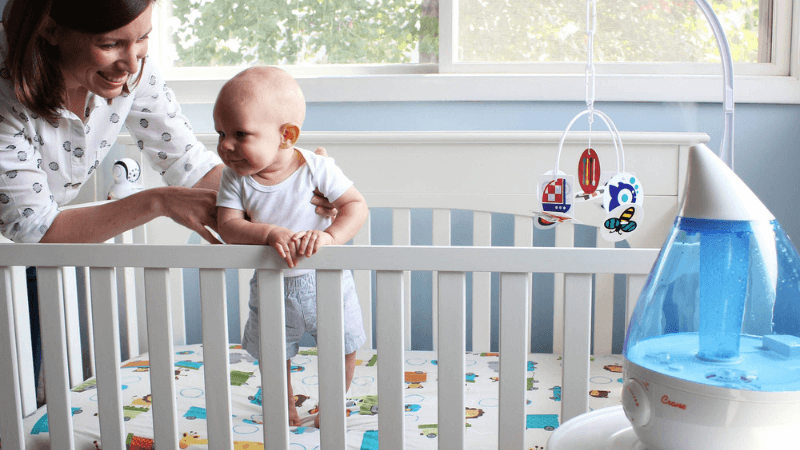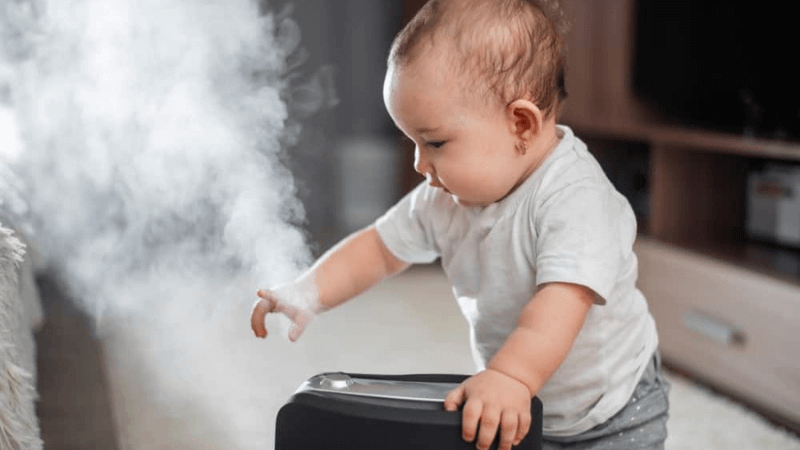When setting up a baby’s nursery or room for the first time, expectant or new parents pick out every detail in the room with extreme care.
One important gadget that is often overlooked is a humidifier.
Babies are more susceptible to congestion, and a humidifier alleviates this and other problems caused by dry air. Adding a little moisture to a baby’s room might also be what they need to drift off to sleep comfortably.
Where should the humidifier be placed to prevent accidents?
[snippet]The best distance to position a humidifier in a baby’s room is where mist does not reach or land directly on the baby or Crib. About six feet away is advised depending on the humidifier. Also, ensure the cord is secure and away from a baby’s reach to avoid accidents.
[/snippet]Humidifier Placement Guide in a Baby’s Room
1. Distance from the baby’s room or Crib
A humidifier should be placed several feet away from the baby’s room or bed. Putting it too close to the baby exposes them to direct water mist or vapor. In this case, it makes no difference whether you use a cool-mist or warm-mist humidifier; keep it 3-4 feet away from where the baby sleeps.
Again, some humidifiers make a lot of noise when they work, disrupting the baby’s sleep. However, suppose the baby is suffering from a cold, and you are using a warm-mist humidifier. You may need to position the humidifier slightly closer to the baby’s bed during the night. This is a temporary measure, and you don’t have to place the humidifier close to the child as soon as they feel better.
2. The Structure of the Room
The best place for a humidifier is the center of the room to ensure even moisture distribution.
You can place the humidifier on top of a table in the center of the room. If you do this, I recommend covering the table with a moisture-resistant cloth to prevent the water vapor or droplets from damaging the table’s surface.
However, if you cannot place the humidifier in the center of the room, you can put it anywhere around the center. Avoid placing it near the room’s sides or edges, as the moisture will not cover a large area and distribute evenly, reducing the humidifier’s performance.
Positioning a humidifier away from direct sunlight is advised. Also, ensure that the table or furniture you place the humidifier on is stable. If not, fasten it to the floor to prevent the baby from accidentally swaying the furniture together with the humidifier.
3. The Child’s Reach at a Humidifier
The humidifier should be placed above the floor that the baby cannot reach. If you set it where a child can easily reach it, they may pull the cord out of curiosity, resulting in spillage and a shock or burn.
As a result, you should position a humidifier away from a child’s reach to ensure that they cannot reach the humidifier. However, you don’t have to worry about the height of an infant who cannot move.
Best Baby Humidifiers
- Best Overall – Crane Drop Ultrasonic Cool Mist Humidifier
- Best High-end – Venta LW25 Original
- Best Budget – Safety 1st 360 Degree Seafoam
- Best Humidifier Diffuser for Baby – Frida Baby Fridababy 3-in-1
Pros of Humidifier in Baby’s Room
- It will help protect the child’s skin from drying out. A baby’s skin is tender, so dry air can make it dry. A humidifier offers extra moisture in the air, thus moisturizing the baby’s skin.
- It helps reduce nasal congestion by loosening mucus, especially when the baby has a cold. A humidifier offers continuous moisture that comforts the throat and opens up the nasal passages making breathing easier for the baby.
- A humidifier also helps keep the skin moist for a child with eczema or cradle cap. A humidifier helps soften the rough, dry patches of cradle cap and eczema. This will result in less redness and irritation of the skin. Therefore, a humidifier eases the symptoms of skin conditions.
- It prevents snoring. Snoring is normal for newborns who are still clearing amniotic fluid from their nasal passages. Also, congestion, dryness, and clogged nasal passages cause snoring. Therefore, a humidifier helps moisturize the nasal canal leading to easy breathing and reduced snoring.
- It helps soothe the baby. Some babies have difficulties staying asleep for an extended period. If you use a humidifier in a baby’s room, the white noise produces is comforting and can help soothe the baby to sleep.
- It helps reduce bacteria and viruses. A baby’s immune system is not fully developed, making them more prone to viruses and bacteria. A humidifier adds the required moisture into the air. Bacteria and viruses don’t travel well in moist air. Therefore a humidifier will add an extra layer of protection between the baby and these common seasonal illnesses caused by bacteria and viruses.
Cons of a Humidifier in Baby’s Room
- Placing a humidifier too close to a baby will expose the baby to micro-organisms that can cause allergies. As a humidifier gives out steam, the steam can harbor disease-causing micro-organisms. This, when exposed to the baby, can result in disease and illnesses. To avoid this, keep the humidifier clean and place it further from the child.
- If the noise level of the humidifier is high, it will be hard for the baby to have a peaceful sleep. Even though most humidifiers operate quietly, one so close to the baby might be so loud for them.
Humidifier Safety Tips for Babies
- Do not place your humidifier close to a vent.
- Don’t allow cords to cross your path as you would trip and fall.
- Don’t place the humidifier close to any electrical outlet.
- Don’t position the humidifier close or on any heated surface, for example, a radiator.
Prevent Accidents by Safe Placement of a Humidifier
A humidifier should be placed at a safer distance for your child’s safety. As long as you place it correctly according to the safety guidelines in this post, there will be no problems. A humidifier might be the device you need to add a little moisture in a baby’s room to get them to sleep comfortably.



